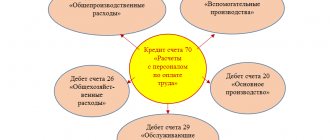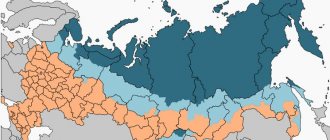Necessity and significance of position 70
All business entities, regardless of their form of ownership, hire employees and pay them wages, the correct accounting of which is necessary in terms of fulfilling obligations to the budget and extra-budgetary funds, and collecting information on personnel costs.
70 position exists to summarize data on the fulfillment of obligations to the organization’s employees regarding the payment of remuneration for work done, including bonuses, benefits, pensions and other social obligations, as well as the costs of paying dividends on shares and other securities issued separately companies.
On its credit side, accountants reflect expenses such as:
- accrued amounts for remuneration for work performed by employees in combination with accounts for the costs of manufacturing products and other sources;
- calculated costs for annual payment of vacation pay and long-service bonuses at the expense of a specially created reserve;
- accrued benefits under social insurance and other similar amounts;
- accrued income from participation in the capital of this organization.
In the debit part, the accounting service records the amounts of remuneration, bonuses, pensions and benefits paid, and taxes and other deductions withheld on them.
Analytical accounting for this position is carried out separately for each specialist of the organization.
Count 70 – active or passive?
To understand whether the 70 account is active or passive, let’s look at its structure. To do this, let's see how the revolutions increase and decrease. Counting scheme 70:
| Opening balance | |
| Debit | Credit |
| Various deductions and the fact of payment of income (salaries, vacation pay, bonuses, benefits, etc.) are reflected. | Accruals of salaries and other types of income are reflected |
| Opening balance |
From the above figure it is clear that credit 70 of the account shows the accrual of amounts of wages, benefits and other income in correspondence with accounts - , , 20, , , 29, 28, , 96, etc. And debit 70 of the account shows the amount of salaries already paid , salaries, benefits, bonuses, allowances, as well as the amount of deductions in terms of personal income tax, alimony, loans, etc. In this case, the correspondence of account 70 depends on the type of deduction and the method of issuing funds - , , , 52, 69, , , , 71, , 79.
Therefore, count. 70 is passive, meaning it usually has a credit balance. In this case, the debit of account 70 means the debt of the employee, and the credit means the debt of the enterprise.
Operations on debit and credit parts
If you look at typical accounting records, you can see that the debit part of the account reflects the following transactions:
- payment of systematic remuneration to employees in cash;
- transfer of funds to pay employees;
- deduction of debt on the accountable amount from accrued wages;
- deduction from the amount of remuneration for work done of travel expenses that were not recognized by the employer;
- deduction from the salary of the guilty person of the identified shortage.
On the credit side, the accountant records the accrued amounts of wages, bonuses, vacation pay and other payments.
Account 70 “settlements with personnel for wages”
Attention
The concept of salary is regulated by the legislator as the remuneration due to the employee for his work and paid by the employer. The basis for carrying out work and receiving material remuneration is an employment contract, but labor relations can take place without it.
The law allows you to work in a new place for 3 days and then sign an agreement; in other cases, there is a formal approach to the employment contract or no one at all. But in any case, if there was an employment relationship, then the material remuneration is recognized by the court as salary. The Labor Code states that the salary includes 3 parts of payments: Salary is a fixed part and depends on the amount of time worked (days, hours).
Postings to 70 payroll items
When keeping records of the indicated amounts, the accounting service enters such standard accounting entries as:
1) Dt 20
Kt 70 – payroll for employees of the main production;
2) Dt 44
Kt 70 – accrual of salaries for employees who ensure the process of product sales;
3) Dt 69
Kt 70 – accrual of benefits for sick leave;
4) Dt 91
Kt 70 – calculation of quarterly bonus.
Accounting for payroll calculations
The table describes some of them. D23/K70 Payroll operation for employees performing routine repair work D08.3/K70 Write-off of costs for investments in non-current assets D08.4/K70 Accounting for the enterprise's own expenses associated with the purchase of fixed assets D29/K70 Cash accrued to employees involved in maintenance production and various types of farms D97/K70 Recognition of costs for the restoration of fixed assets as future expenses D44/K70 Transferred funds to employees who ensure the sale of products D91/K70 Accrued funds for the salaries of people involved in dismantling equipment D08.1/K70 Incurring costs for wages Account balance In most cases, the account balance is 70 credit and means the enterprise's debt to personnel.
Statute of limitations
The legislator does not recommend delaying filing an application to court if the issue is not resolved peacefully, because the statute of limitations for labor disputes expires after 3 months .
The three-month period begins from the moment the employee learns that his rights have been violated by the employer, which means that it cannot always be determined precisely. If the applicant misses the deadline that the legislator provides for his defense in court, the debts will not be repaid.
But missing the established period may occur for a good reason, for example, illness, then, according to the Labor Code, the period will be restored in court. To do this, you will have to submit the relevant documents, to which the court is very demanding, and also convince the judges that the applicant can exercise his right to restore the 3-month period for filing an application for overdue debt.
At an enterprise, overdue debts to employees for wages are reflected in a special balance sheet account until they are paid or written off at the end of the statute of limitations.
Accounting for settlements with personnel regarding wages.
All operations related to the calculation of wages, charges on it and deductions made from it are subject to reflection in the accounting accounts in the reporting period of accrual, regardless of the period of payment of wages to employees and the transfer of tax payments to the budget and insurance contributions to state extra-budgetary funds.
Accounting for settlements with personnel for remuneration and deductions from wages is carried out on active-passive account 70 “Settlements with personnel for remuneration”, which has the following structure:
Account 70 “Settlements with personnel for wages”
| Debit | Credit |
| Balance (initial) - the amount of debt of the organization to personnel for wages at the beginning of the reporting period | |
| Calculation of personal income tax withheld from employee wages accrued during the reporting period | Accrual of wages due to employees during the reporting period in accordance with the remuneration system applied by the organization |
| Accrual of other deductions from employees' wages during the reporting period | |
| Payment of wages to staff during the reporting period | |
| Turnover by debit | Loan turnover |
| Balance (final) - the amount of the organization's debt to personnel for wages at the end of the reporting period |
In development of account 70 “Settlements with personnel for wages”, analytical accounts are opened to record settlements for wages with each employee of the organization.
Account 70 “Settlements with suppliers for wages”, as a rule, has a credit balance, which is reflected in the liability side of the balance sheet in section V “Short-term liabilities” in a separate article “Debt to personnel for wages”.
In rare cases, in settlements with individual employees, their receivables may arise to the organization for settlements of wages; in this case, account 70 “Settlements with personnel for wages” will simultaneously have a debit balance along with the credit balance, which is reflected in section II “Current assets” balance sheet asset as part of short-term receivables.
Payroll
means an increase in the organization's debt to personnel and a simultaneous increase in the organization's expenses for ordinary activities. Therefore, this operation is reflected in the credit of account 70 “Settlements with personnel for wages” in correspondence with the debit of the corresponding expense accounts: 20 “Main production”, 25 “General production expenses”, 26 “General expenses”.
All deductions made from the employee’s wages are reflected in the debit of account 70 “Settlements with personnel for wages”, since the amount of deductions reduces the amount to be paid to the employee. Account 70 “Settlements with personnel for wages” corresponds with the accounts for the corresponding types of deductions, for example:
∙ with a credit to account 68 “Calculations for taxes and fees” - for the amount of withheld tax on personal income;
∙ with the credit of account 71 “Settlements with accountable persons” - for the amount of deductions made to repay amounts issued for accounting, etc.
the remaining part of the wages after deductions are made is subject to payment to employees. In accordance with the Labor Code of the Russian Federation, wages must be paid at least twice a month: an advance is paid for the first half of the month.
Wages are paid to the employee, as a rule, from the cash desk at the place where he performs the work, which is reflected in the accounting records:
Debit of account 70 “Settlements with personnel for wages” and
Account credit 50 “Cash”.
Wages are issued from the organization's cash desk within three days from the date of its receipt from the bank account, after which the amounts of unpaid wages are transferred to the bank account.
Based on the employee’s application, the wages due to him can be transferred to the bank account specified by him (plastic card), which will be reflected in the accounting records as follows:
Debit of account 70 “Settlements with personnel for wages” and
Account credit 51 “Current account”.
The transfer of personal income tax withheld from an employee’s salary to the budget is reflected in the accounting records by the entry:
Debit account 68 “Calculations for taxes and fees” and
Account credit 51 “Current account”.
To account for the organization’s settlements with state extra-budgetary funds for insurance contributions for compulsory social insurance of employees, active-passive synthetic account 69 “Settlements for social insurance and security” is used, for the development of which the following sub-accounts are opened:
69-1 “Calculations for social insurance”;
69-2 “Calculations for pension provision”;
69-3 “Calculations for social insurance and security” has the following structure:
Account 69 “Calculations for social insurance and security”
| Debit | Credit |
| Balance (initial) - the amount of receivables of state extra-budgetary funds to the organization for settlements of insurance premiums at the beginning of the reporting period | Balance (initial) - the amount of accounts payable of the organization to state extra-budgetary funds for settlements of insurance premiums at the beginning of the reporting period |
| Transfer of insurance contributions to the relevant state extra-budgetary funds during the reporting period | Accrual of insurance premiums during the reporting period to be transferred to the relevant extra-budgetary funds |
| Accrual of benefits to employees from the Social Insurance Fund during the reporting period | |
| Payment of wages to staff during the reporting period | |
| Turnover by debit | Loan turnover |
| Balance (initial) - the amount of receivables of state extra-budgetary funds to the organization for settlements of insurance premiums at the end of the reporting period | Balance (initial) - the amount of accounts payable of the organization to state extra-budgetary funds for settlements of insurance premiums at the end of the reporting period |
Account 69 “Calculations for social insurance and security” has an expanded balance, the debit balance is reflected in the balance sheet asset in section II “Current assets” as part of short-term receivables, the credit balance on this account is reflected in the balance sheet liability in section V “Short-term liabilities” a separate article “Debt to state extra-budgetary funds”.
Accrued amounts to the listed state extra-budgetary funds are reflected in the credit of account 69 “Calculations for social insurance and security” in correspondence with the debit of those accounts for accounting for production and management costs to which the amounts of accrued wages in respect of which insurance contributions were calculated were allocated .
Part of the amounts subject to transfer to the Social Insurance Fund of the Russian Federation can be used by the organization to pay temporary disability benefits to employees, etc. Accordingly, the amount of the organization's debt subject to transfer to the Social Insurance Fund of the Russian Federation will be reduced by the amount of temporary disability benefits accrued to the organization's employees. , which will be reflected in the debit of account 69 “Settlements for social insurance and security” in correspondence with the credit of account 70 “Settlements with personnel for wages”, since the organization has accounts payable to employees for the payment of accrued benefits to them.
As the monthly mandatory payments for insurance premiums become due, the organization transfers them by bank transfer to the relevant state extra-budgetary funds (minus the amounts actually paid to employees from the Social Insurance Fund of the Russian Federation).
The business transaction for the transfer of insurance contributions will be reflected in the debit of account 69 “Calculations for social insurance and security” and its corresponding subaccounts 1 “Calculations for social insurance”, 2 “Calculations for pension provision”, 3 “Calculations for compulsory medical insurance” in correspondence with the credit of account 51 “Current accounts”.
Payers of insurance premiums are required to keep records of the amounts of accrued payments and other remunerations, the amounts of insurance premiums related to them, in relation to each individual in whose favor the payments were made.
Accounting records for accounting transactions for settlements with personnel for wages are given in Table 8.2.
Table 8.2
Set of standard accounting entries for accounting transactions
according to settlements with personnel for wages
| Contents of operation | Amount, rub. | Corresponding accounts | |
| Debit | Credit | ||
| 1. Wages accrued to employees | 100 000 | Expense accounts: 20 “Main production”; 25 “General production expenses”; 26 “General business expenses” | 70 “Settlements with personnel for wages” |
| 2. |
Account 70 “Settlements with personnel for wages”
The personal income tax calculated by the organization (at a rate of 13%) is withheld from the wages accrued to employees.
13 00070 “Settlements with personnel for wages”68 “Settlements for taxes and fees”3. Insurance contributions have been accrued to state extra-budgetary fundsAccounts for recording production and management costs69 “Calculations for social insurance and security”∙ Social Insurance Fund of the Russian Federation (2.9% of accrued labor costs)2 90020 “Main production”∙ subaccount 1 “Calculations for social insurance and security"∙ Pension Fund of the Russian Federation (22% of accrued expenses for remuneration of employees)22 00025 "General production expenses"∙ subaccount 2 "Calculations for pension provision"∙ Federal Compulsory Medical Insurance Fund (5.1% of accrued expenses for wages of employees)5 10026 “General business expenses”∙ subaccount 3 “Calculations for compulsory health insurance”4. Temporary disability benefits have been accrued at the expense of the Social Insurance Fund1 00069 “Calculations for social insurance and security”, subaccount 1 “Calculations for social security”70 “Settlements with personnel for wages”5. To pay employees wages and temporary disability benefits, cash was received from the current account to the organization’s cash desk (87,000 + 1,000)88 00050 “Cash desk”51 “Current account”6. From the cash register of the organization, wages and accrued benefits for temporary disability were paid to employees88 00070 “Settlements with personnel for wages”50 “Cash desk”7. The personal income tax withheld from wages is transferred from the current account to the budget13 00068 “Calculations for taxes and fees”51 “Current account”8. Insurance contributions to state extra-budgetary funds were transferred from the current account69 “Calculations for social insurance and security”51 “Current account”∙ Social Insurance Fund of the Russian Federation (the difference between accrued insurance contributions and accrued temporary disability benefits to employees) (2,900 – 1,000)1 900∙ subaccount 1 “Calculations for social security”∙ Pension Fund of the Russian Federation22,000∙ subaccount 2 “Calculations for pension provision”∙ Compulsory medical insurance funds5 100∙ subaccount 3 “Calculations for compulsory medical insurance”Date added: 2015-10-09; ;
The organization's liabilities include amounts accrued to employees as wages. Information on settlements with personnel for wages is presented in the balance sheet (form No. 1), profit and loss statement (form No. 2), cash flow statement (form No. 4), annex to the balance sheet (form No. No. 5), a report on the intended use of funds received (form No. 6) and an explanatory note. In accordance with clauses 5, 7 of the Accounting Regulations “Expenses of the Organization” (PBU 10/99), approved by Order of the Ministry of Finance of Russia dated May 6, 1999 N 33n, the organization’s expenses for remuneration of employees form expenses for ordinary activities. Payroll is reflected in accounting by the following entry: Dt inc.
Description of wage arrears
Transfers from the current account to repay debts to suppliers for materials received are reflected +D 60 K51 2. The balance of the “Settlement Accounts” account is reflected + in the balance sheet asset as part of current assets 3. materials are + objects of labor that are entirely consumed in each production cycle and transfer their entire cost to finished products 4. Balance on the “materials” account + availability of materials in warehouse 5.
Receipt of materials to the warehouse from suppliers is reflected +D 10 K60 6. The release of materials from the warehouse to the main production for the manufacture of products is reflected +D 20 K10 7. The balance of the “materials” account is reflected + in the balance sheet asset as part of current assets 8. Calculation of wages (increase in accounts payable to the organization’s personnel) is reflected + on the credit of account 70 9.
Other Typical Wiring
Payment of dividends is not the only type of settlement with the founders. For example, a participant may issue a loan to an organization. This operation also needs to be taken into account in accounting. Let's look at other typical wiring:
- DT50, 51 KT66, 67. The founder provided financial assistance to the organization. It is framed as a loan.
- DT50, 51 KT91/1. The person provided gratuitous assistance, which is classified as other income.
- DT75 KT84. Receipt of funds from the founder to cover current losses.
To maintain accounting, you need synthetic (general ledger, balance sheet) and analytical (account card 75, analysis) registers.
Income tax
If the participant is a resident, the company paying the dividends does not need to charge income tax. If the participant is a non-resident, the tax is calculated on the difference between the real and nominal value. The corresponding rule is given in paragraph 1 of Article 309 of the Tax Code of the Russian Federation. If a foreign entity receives payments in the amount of its initial contribution, tax does not need to be assessed on the basis of paragraph 1 of Article 251 of the Tax Code of the Russian Federation.
The income tax rate is 20%. A lower rate is also possible if the corresponding instructions are given by international treaties (based on paragraph 1 of Article 310 of the Tax Code). Income tax is calculated using this formula:
Income tax = present value of the deposit – (nominal value * 20%)
The corresponding instructions are given in paragraph 1 of Article 251 of the Tax Code of the Russian Federation. The taxation procedure is specified in the letter of the Ministry of Finance No. 03-03-06/1/519 dated August 3, 2010.
Account 70 in accounting: settlements with personnel for wages
Important
Employers abuse their position due to impunity and grossly violate the labor rights of Russian citizens. Often, wages are underpaid month after month, and each employee has a large debt.
The legislator assures that the collection of arrears of wages is possible; citizens are recommended to go to court, which is the most effective method of protecting labor rights. But first you should try to resolve the issue peacefully:
- by sending a complaint to the management of the employing company;
- by contacting the labor inspectorate;
- by writing a complaint to the prosecutor's office;
- by preparing a statement of claim in court and notifying the employer that it will be filed.
After contacting the labor inspectorate, it is obliged to respond and send an unscheduled inspection to the enterprise to determine the reason for the debt to the employee.
Account 70 in accounting: “settlements with employees for wages”
InfoRequired documents To file a statement of claim in the form established by the legislator, the applicant must contact the territorial branch of the court according to registration. In addition to the application, the package of documents must include:
- contract or employment agreement;
- job description;
- orders on hiring and dismissal;
- income certificate;
- calculation of overdue debts;
- documents that can indirectly confirm the applicant’s correctness.
Collection percentage When calculating the total amount of salary arrears, it is necessary to take into account that deductions from it do not exceed 20%.
Calculation of dividends
The founders have the right to receive profits in the form of dividends. The terms of payments are stipulated by the constituent documents. The decision on the distribution of funds is made by the management structure. For example, this could be a shareholders meeting. The founders are paid dividends in the amount of the initial contribution. For example, the creator contributed 50% of the authorized capital. Consequently, he becomes entitled to half of the organization's profits. To account for dividend payments, subaccount 2 is opened to account 75.
The accrual of funds to the founder is reflected in these entries:
- DT84 KT75/2. Payment of dividends to persons who are not employees of the organization.
- DT84 KT70. Transfer of dividends to company employees.
Funds must be paid to the founders within 2 months from the date of the decision on profit distribution. The corresponding rule is given in paragraph 3 of Article 28 of the Federal Law “On LLC” No. 14 of February 8, 1998. If this instruction is violated, the founders can recover from the LLC a percentage in the amount of 1/360 of the refinancing rate on the basis of Article 395 of the Civil Code of the Russian Federation.
The following taxes are charged on dividends:
- For FL income.
- For the profit of the legal entity.
The tax agent will be the company itself. The rate for residents of the country will be 13%. The tax base for dividends is determined separately. For example, if a person receives a salary and dividends, the base must be calculated separately from these forms of income.
IMPORTANT! A resident is a person who stays in the country for at least 183 days throughout the year. The period must be continuous.
The income tax rate is 0% when one resident receives funds from another resident. However, the following conditions must be met:
- The dividend recipient's contribution is 50% or more of the authorized capital.
- The recipient holds the deposit for at least a year.
In other cases, the rates will be as follows:
- 13% if dividends are issued by a company that does not meet the conditions given above.
- 15% if funds are paid to non-residents.
These entries will appear in the accounting:
- DT75/2 KT68. Withholding personal income tax on dividends paid to persons who are not employees of the organization.
- DT70 KT68. Withholding personal income tax from amounts transferred to employees of the subject.
- DT75/2 KT68. Withholding tax on payments to legal entities.
At this stage, funds are only credited. Preparations for payment are in progress.
Accounts payable is
Return of funds in favor of other persons Accounts payable is a type of obligation characterizing the amount of debts due for payment in favor of other persons. The essence of accounts payable The most common type of accounts payable is debt to suppliers and contractors for supplies supplied, services provided and work not paid on time. Accounts payable can be terminated by fulfillment of the obligation (including offset), and also written off as unclaimed.
Debt to suppliers and contractors As part of accounts payable, the organization's debt is distinguished: - to suppliers and contractors (balances as of the reporting date on the credit of accounts 60 “Settlements with suppliers and contractors” and 76 “Settlements with various debtors and creditors”); The enterprise’s debt to suppliers is to the organization’s personnel (the balance on the credit of account 70 “Settlements with personnel for wages”); Debt to the employees of the enterprise - to the budget (balance on the credit of account 68 “Calculations for taxes and fees”); Debt to the budget - to state extra-budgetary funds (credit balance on account 69 “Calculations for social insurance and security”); Debt to extra-budgetary funds - for loans and credits received (credit balances of accounts 66 “Settlements for short-term loans and borrowings” and 67 “Settlements for long-term loans and borrowings”); Debts on loans - to other creditors (credit balances on accounts: 71 “Settlements with accountable persons”, 73 “Settlements with personnel for other transactions” and others).
Value added tax
If dividends are paid to a participant leaving the association in the form of property, VAT is charged on the difference between the real and nominal value. An invoice is also issued on the basis of paragraph 2 of Article 146 of the Tax Code of the Russian Federation, paragraph 3 of Article 39 of the Tax Code of the Russian Federation. The instruction is also contained in the letter of the Ministry of Finance No. 03-07-11/112 dated April 17, 2012. In the event that subjects use special taxation systems, VAT does not need to be paid on the basis of Article 346.11 of the Tax Code of the Russian Federation, Article 346.26 of the Tax Code of the Russian Federation. To reflect the accrual of VAT, this posting is used: DT91/2 KT68. A sub-account is opened for the last account.
IMPORTANT! The object of taxation appears only when there is a positive difference between the real and nominal value of the deposit. In the event that the positive difference is paid to the founder, no taxable object will be created.








